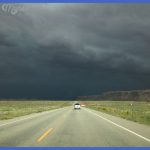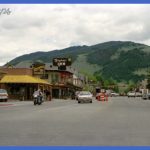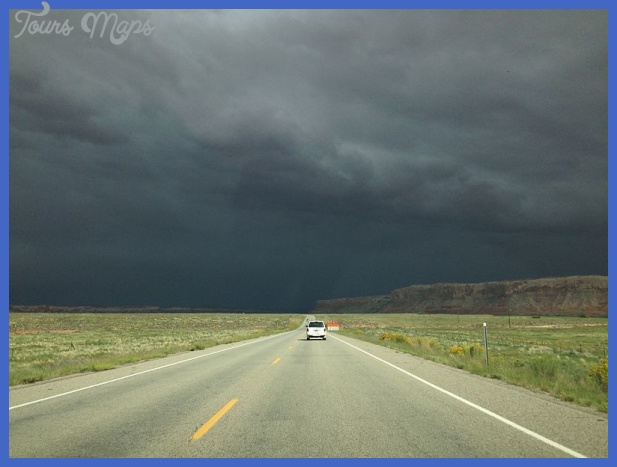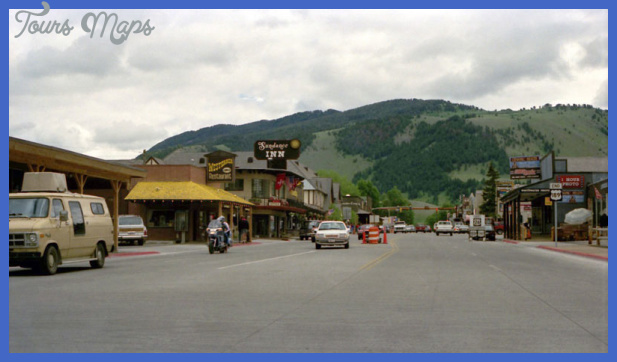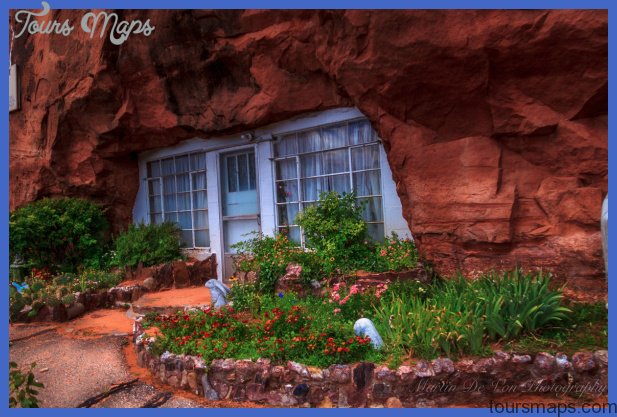Approximately 60 miles (96 km) from Bozeman, Highway 191 enters the northwestern corner of Yellowstone and continues inside the park for about 20 miles (32 km), crossing in and out of Wyoming and Montana. There are no campgrounds, picnic areas, or restrooms along this stretch of road, but there is access to several trails into the backcountry, both in the park and in Gallatin National Forest. This road was first built in 1910-11 and now passes through land that was added to the park in 1929. Road 0.0/20.5 Yellowstone National Park boundary. Just a large sign marks the edge of the park here; there’s no entrance fee to pay until you reach the West Entrance station.
This short stretch of U.S. 191 is the only road within the park where the speed limit is 55 miles per hour rather than 45. The only park road used by large trucks, it’s open year round. The mountains northeast of the road Log (to your left as you enter the park) are Crown Butte (elevation 8051 ft/2454 m) and Lava Butte (7904 ft/2409 m). Crown Butte resembles a crown when seen from the south. Geologists tell us that both Crown Butte and Lava Butte (a mile or two farther along) are topped with Huckleberry Ridge tuff, the 2-million-year-old welded volcanic ash that can be seen in several localities in the park. Here the tuff overlies shale, a sedimentary rock rich in clays. Shale weathers and erodes easily, producing landslides that sometimes encroach upon the road. Entering park territory, you are by the volcanic cone of Black b 0.9/19.6 (S 0 Dailey Creek Trail-head. Small parking area and Dailey Creek crossing. Dailey Creek was named for one of the first families to winter in the valley on the other side of the Gallatin Range.
The family arrived in 1866 and still had a ranch there in the 1930s. Lodgepole Creek joins the Gallatin from the (west) side opposite Dailey Creek. Note that locals pronounce the word creek like CRICK, to rhyme with trick. All trails in this part of the park are long, steep ones that lead into the Gallatin Range. Dailey, Black Butte, and Specimen Creek trails all join with the Sky Rim Trail 5 miles or more away and 3000 feet up (about 8 km away and 900 m up). The Sky Rim Trail affords spectacular mountain views to the very hardy climber or horseback rider. Also, some stumps of petrified wood are preserved there, but they are harder to reach and less interesting than those on Specimen Ridge in the Lamar River valley. Both grizzlies and black bears live in this northwest corner of Yellowstone. Along the far side of the river, you’ll see red-tipped white stakes marking the park boundary. 2.6/17.9 Black Butte Creek Trail-head; parking area on the west, trail on the east. This is the shortest but steepest of the trails that connect to the Sky Rim Trail. 3.0/17.5 The almost perfect cone shape of Black Butte looms over the road to the east. Geologists call Black Butte an igneous intrusion. This means that it’s made of rock that rose as a molten mass from deep within the earth, but stopped and crystallized before reaching the earth’s surface. Since the overlying rocks eroded away, we can now see the intrusion. Black Butte’s rock is about 50 million years old. 3.9/16.6 There’s a tiny stream called Wickiup Creek here. A wickiup was a temporary shelter used by nomadic tribes of Native Americans.
Long poles placed in a circle with their tips joined together were covered with skins or brush. A group of these hunting lodges stood near the stream here in the park’s early days. 4.6/15.9 0 Specimen Creek Trail-head. This trail connects to the Sky Rim, High Lake, and Sportsman Lake trails. In spite of its name, this is not the best route to take to see petrified wood specimens. A ranger or local resident can best advise you on how to reach them. Remember that no samples may be removed from the park. Two easier ways to see petrified trees are by hiking from Yellowstone’s northern approach road north of Gardiner, Montana, and at Petrified Tree near Tower-Roosevelt Junction. To the east is Lightning Hill, so named when rangers from the now-razed ranger station near Wickiup Creek used to climb it to check for lightning-caused fires. 6.1/14.4 To the west, Snowslide Creek cascades into the Gallatin River in an area that’s marshy except when the creek dries up in late summer. On the far side of the river along here, you can see remnants of the original road through Gallatin Canyon. 7.1/13.4 Terminal Monument Creek crossing. The strange name of this creek stems from a wooden post placed up the hill to the northeast that marks the northwest corner of the state of Wyoming. 7.5/13.0 Gallatin River Bridge. 7.6/11.9 0 Bacon Rind Creek Trail begins 0.3 mile (0.5 km) up the side road to the west. After the first 2.5 miles (4 km), the trail continues out of the park into the Lee Metcalf Wilderness. The century-old name Bacon Rind Creek probably referred to breakfast around the campfire or to an old way to bait bears by hanging bacon rind in a tree. As you travel south, you begin to see the snags, that is, standing burned trees left from the Fan fire, one of 1988’s many Yellowstone fires. 9.3/11.2 (S 0 Fan Creek and Fawn Pass trailheads. Fan Creek flows into the Gallatin from the northeast through a valley that 19 th century geologists thought looked like a large fan, because of its radiating minor valleys.
Both trails take hikers and riders into the southern expanses of the Gallatin Range. To see an undisturbed, beautiful mountain valley, you might follow the start of the Fan Creek Trail for about 2 miles (3 km), turning northeast at the trail junction. 10.5/10.0 From this point south, we no longer follow the Gallatin River. The river flows west from its source in the high Gallatin Mountains, then turns north here and meanders through the flat floodplain that you’ve just traversed if traveling southward. This is also the Montana/Wyoming state line. 10.9/9.6 Bigh orn Pass Trailhead. The sign indicates a short side road primarily for unloading horse trailers. The Bighorn Pass Trail follows the Gallatin River almost to its source at Gallatin Lake some 12 miles (19 km) away and 2000 feet (610 m) up. Both the Bighorn Pass and Fawn Pass trails continue across the high mountains and all the way to the Grand Loop Road between Mammoth and Norris. Looking east up the Gallatin River here, you see Bannock Peak (10,332 ft/3149 m), with Quadrant Mountain (10,213 ft/3113 m) behind it. In the 1920s, citizens and Milwaukee Road ocials were eyeing the Bighorn Pass Trail route as an attractive place to build a road or a railroad. We must thank National Park Service’s first director, Stephen Mather, and Yellowstone Park Superintendent Horace Albright for their foresight in objecting to these plans.
Long before designated wilderness areas were thought of, Mather wrote to Albright: We must keep a large area of Yellowstone in a state of untouched wildness if we are to be faithful to our trust as protectors of the wild life with which the park abounds. The road was not built, nor was the railroad company even allowed to conduct a survey. 12.0/8.5 Divide Lake, at an elevation of about 7250 feet (2210 m), takes its name from the fact that water flows from this vicinity into two different watersheds. To the north all streams flow to the Gallatin River, while to the south they flow to the Madison River. These rivers (along with the Jefferson River) join to form the Missouri River, and their waters eventually flow to the Atlantic Ocean. 14.0/6.5 Pass Creek and 0 Grayling Creek join here. U.S. 191 parallels Grayling Creek until that creek’s southern exit from the park, crossing it three or four times. The old road crossed the creek a dozen or more times, so that the builders could avoid excavating the sidehills. The road skirts a severely burned area at the northwestern reach of the 1988 North Fork fire.
Along U.S. 191 in the Park Photo Gallery
Maybe You Like Them Too
- The Best Cities To Visit in The World
- World’s 10 Best Places To Visit
- Coolest Countries in the World to Visit
- Travel to Santorini, Greece
- Map of Barbados – Holiday in Barbados

